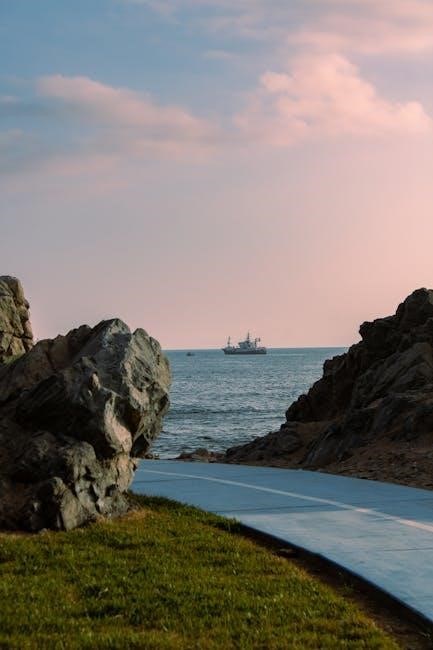Moquegua, founded by the Spanish in 1541 as Villa de Santa Catalina de Moquegua, is a region rich in cultural and historical significance. Known as the “Valle del Sol,” it has played a pivotal role in Peruvian history, blending indigenous traditions with colonial influences. Its history spans thousands of years, from pre-Columbian settlements to modern-day developments, making it a fascinating subject for historical exploration.
Overview of Moquegua’s Historical Significance
Moquegua holds a unique place in Peruvian history, serving as a cultural and economic crossroads. Founded by the Spanish in 1541, it became a hub for viticulture and agriculture, earning it the nickname “Valle del Sol.” The region’s historical significance is marked by its role in the country’s independence movement and its resilience through economic challenges. Archaeological findings reveal a rich pre-Columbian heritage, with influences from the Uros, Puquinas, and Incas. The city’s colonial architecture and vibrant festivals reflect a blend of indigenous and Spanish traditions. Moquegua’s history is also tied to its volcanic landscapes, with events like the 1600 Huaynaputina eruption shaping its trajectory. Today, it stands as a symbol of cultural preservation and adaptability, offering insights into Peru’s diverse past and its ongoing contributions to national identity.
Geographical Context of Moquegua
Moquegua is situated in southern Peru, bordered by the Andes Mountains to the east and the coastal plains to the west. Its capital, also named Moquegua, lies at 1,410 meters above sea level, nestled in the fertile valley of the Osmore River. The region’s geography is characterized by its arid climate, with intense sunlight and limited rainfall, earning it the nickname “Valle del Sol.” The proximity to active volcanoes like Ubinas and Huaynaputina has shaped its landscape and history, with volcanic soil enriching the land for agriculture. The region is divided into three provinces: Mariscal Nieto, General Sánchez Cerro, and Ilo, each contributing to its ecological diversity. Moquegua’s strategic location has made it a crossroads for trade and cultural exchange, influencing its historical and economic development.
Importance of Studying Moquegua’s History
Studying Moquegua’s history is essential for understanding the cultural, social, and economic dynamics of southern Peru. Its unique blend of indigenous and colonial influences offers insights into the region’s resilience and adaptation. The area’s historical significance, from pre-Columbian settlements to its role in Peruvian independence, highlights its contributions to national identity. Moquegua’s wine production and agricultural traditions reveal its economic importance, while its archaeological sites, such as those of the Chiribaya culture, provide a window into its ancient past. By examining Moquegua’s history, researchers can explore themes of colonialism, cultural preservation, and modernization. This study also illuminates the region’s contemporary challenges and its efforts to balance progress with cultural heritage. Ultimately, Moquegua’s history serves as a microcosm for broader historical trends in Peru and South America, making it a valuable subject for scholarly and cultural exploration.

Pre-Columbian Era in Moquegua
Moquegua’s pre-Columbian history began around 10,400 B.C. with hunter-gatherers, followed by the emergence of agricultural villages like the Huaracane people between 2,000 B.C. and 500 B.C.
Early Settlements and Indigenous Cultures
The early history of Moquegua is marked by the presence of indigenous groups that settled in the region thousands of years ago. Archaeological evidence suggests that the first inhabitants were hunter-gatherers who arrived around 10,400 B.C. Over time, these groups evolved into more complex societies, developing agricultural practices and establishing permanent settlements. One of the earliest known cultures in the region was the Huaracane people, who flourished between 2,000 B.C. and 500 B.C. They were skilled farmers, cultivating crops such as maize and potatoes, and developed sophisticated irrigation systems to adapt to the region’s arid climate.
The Uros, Puquinas, and other pre-Columbian groups also played a significant role in shaping Moquegua’s early cultural landscape. These communities developed unique social structures and traditions, laying the foundation for the region’s rich cultural heritage. Their legacy can still be seen in the archaeological sites and artifacts that dot the Moquegua Valley, offering a glimpse into the lives of these ancient civilizations.
The Role of the Uros, Puquinas, and Incas
The Uros, Puquinas, and Incas were pivotal in shaping Moquegua’s pre-Columbian history. The Uros, known for their aquatic expertise, established floating islands on Lake Titicaca, while the Puquinas developed a distinct culture in the region. The Incas later integrated Moquegua into their empire, introducing advanced administrative systems and infrastructure.
Under Inca rule, Moquegua became a key agricultural hub, benefiting from terracing and irrigation techniques. The Incas also promoted the production of textiles and ceramics, enriching the region’s cultural tapestry. These civilizations left a lasting legacy, influencing Moquegua’s identity and traditions, which are still celebrated today.
Agricultural Developments and Social Structures
Moquegua’s pre-Columbian era was marked by significant agricultural advancements and well-organized social structures. Early settlers, such as the Huaracane people, developed sophisticated irrigation systems to cultivate crops like maize, beans, and squash in the region’s fertile valleys. Terracing became a common practice to maximize arable land and prevent soil erosion.
The social structure was hierarchical, with local leaders overseeing resource distribution and labor organization. These leaders played a crucial role in maintaining communal agricultural projects, ensuring food security and economic stability. The agricultural surplus supported trade networks with neighboring regions, further enriching Moquegua’s cultural and economic landscape.

Colonial Period in Moquegua
Founded in 1541 as Villa de Santa Catalina de Moquegua, the region thrived under Spanish rule, becoming a key producer of wine and experiencing significant cultural and economic transformation during this era.
Spanish Founding and Early Colonial History
Moquegua was founded by the Spanish on November 25, 1541, as Villa de Santa Catalina de Moquegua. The region’s fertile valley and strategic location made it an attractive site for Spanish settlement. Initially, the area was inhabited by indigenous groups such as the Uros and Puquinas, who were later influenced by the Incas. The Spanish established the villa to consolidate their control over the southern Andean region. During the early colonial period, Moquegua became a center for agriculture, particularly viticulture, which would later define its economy. The Spanish introduced European crops and farming techniques, transforming the local landscape. The city’s early history was marked by the blending of indigenous and Spanish cultures, though tensions arose due to colonial exploitation. The founding of Moquegua laid the groundwork for its role as a vital hub in the colonial economy and society of Peru.
Economic Activities and Wine Production
Moquegua’s economy during the colonial period was largely driven by agriculture, with a strong emphasis on viticulture. The Spanish introduced vineyards, and the region became renowned for its high-quality wine production. This industry flourished due to the fertile soil and favorable climate, earning Moquegua the nickname “Valle del Sol.” Wine production not only boosted the local economy but also established the region as a key supplier to other parts of Peru and beyond. Additionally, the area was known for its olive groves and wheat fields, which further diversified its agricultural output. The economic activities in Moquegua were closely tied to its strategic location, facilitating trade with neighboring regions. However, the industry faced challenges, including competition from other wine-producing areas and periodic environmental disruptions. Despite these obstacles, Moquegua’s wine production remained a cornerstone of its colonial economy, shaping its identity and contributing to its prosperity.
Social and Cultural Changes Under Spanish Rule
The arrival of the Spanish in Moquegua in the 16th century brought profound social and cultural transformations. The indigenous population was displaced, and European customs, language, and religion were imposed. The Spanish introduced Christianity, leading to the construction of churches and the blending of Catholic rituals with indigenous traditions. This cultural fusion is evident in the region’s festivals and art. The social hierarchy became more stratified, with Spanish colonizers at the top and indigenous peoples and mestizos in subordinate roles. Agriculture, particularly wine production, became a central economic activity, shaping the daily lives of the population. The Spanish also introduced new technologies and administrative systems, which altered the region’s social structures. Despite these changes, indigenous traditions persisted, creating a unique cultural identity that endures to this day. The legacy of Spanish rule remains visible in Moquegua’s architecture, language, and social practices, reflecting a complex interplay of conquest and adaptation.

19th Century Moquegua
The 19th century marked Moquegua’s rise as a key player in Peruvian independence and economic transformation. Its wine production flourished, and the region became a hub for cultural and political movements, shaping its identity.
Moquegua’s Role in Peruvian Independence
During the 19th century, Moquegua emerged as a significant contributor to Peru’s struggle for independence. The region’s strategic location and economic prosperity made it a vital hub for patriotic movements. In 1821, the province declared its independence, aligning with the broader national movement. Local leaders played pivotal roles in organizing resistance against Spanish rule, leveraging Moquegua’s resources to support the cause. The region’s agricultural wealth and wine production helped finance the independence efforts, while its cultural ties strengthened national unity. Moquegua’s participation in key battles and political negotiations underscored its commitment to freedom. This period not only shaped Peru’s identity but also cemented Moquegua’s legacy as a symbol of resilience and patriotism, reflecting its deep-rooted desire for autonomy and self-governance.
Political and Economic Transformations
The 19th century marked a period of significant political and economic change for Moquegua. Following Peru’s independence in 1821, the region transitioned from colonial rule to republican governance. Politically, Moquegua became a key player in the newly formed nation, with local leaders influencing national policies. Economically, the region diversified its activities, moving beyond its colonial reliance on wine production to embrace mining and agriculture. The expansion of railways and infrastructure during this period connected Moquegua to larger markets, fostering economic growth; However, this transformation also brought challenges, including social inequality and land distribution issues. Despite these hurdles, Moquegua’s strategic location and resource-rich land positioned it as a vital contributor to Peru’s developing economy. These changes laid the groundwork for the region’s modern identity and its role in the nation’s progress.
Cultural Developments and Infrastructure Growth
During the 19th century, Moquegua experienced significant cultural developments and infrastructure growth. The region’s cultural scene flourished with the establishment of educational institutions and the promotion of local arts. Traditional festivals, such as the celebration of Santa Fortunata, gained prominence, reflecting the deep-rooted religious and communal traditions of the area. Infrastructure projects, including the construction of roads and bridges, improved connectivity within the region and facilitated trade. The expansion of urban centers and public buildings, like schools and churches, further enhanced the quality of life for residents. These advancements not only modernized Moquegua but also preserved its cultural heritage, creating a blend of tradition and progress that continues to define the region today. Such developments were instrumental in shaping Moquegua’s identity and laying the foundation for its future growth and prosperity.

20th Century Moquegua
The 20th century brought industrialization and social movements to Moquegua, shaping its modern identity. Economic resilience and cultural preservation marked the era, laying the groundwork for future development and growth in the region.
Modernization and Industrialization
The 20th century marked a transformative period for Moquegua, characterized by rapid modernization and industrialization. The region experienced significant economic growth, driven by the expansion of the wine industry, which became a cornerstone of its economy. Traditional vineyards were modernized, incorporating advanced agricultural techniques and technologies. Additionally, mining and agriculture saw substantial development, contributing to Moquegua’s industrial boom. Infrastructure projects, such as the construction of highways and energy facilities, further facilitated economic progress. The growth of urban centers and the emergence of a middle class reflected the region’s evolving socio-economic landscape. However, this period also brought environmental concerns, as industrial activities impacted local ecosystems. Despite these challenges, Moquegua’s modernization efforts laid the foundation for its contemporary identity as a dynamic and resilient region.
Social Movements and Political Changes
The 20th century witnessed significant social movements and political transformations in Moquegua. Labor unions and community organizations emerged, advocating for workers’ rights and social equity, particularly in the mining and agricultural sectors. These movements played a crucial role in shaping local policies and empowering marginalized groups. Politically, Moquegua experienced shifts in governance, with decentralization efforts aiming to grant more autonomy to regional authorities. Environmental activism also gained momentum, as communities mobilized against industrial projects threatening local ecosystems. These changes reflected broader national trends while addressing unique regional challenges. The interplay of social activism and political reform continues to influence Moquegua’s development, fostering a more inclusive and participatory society. These movements underscore the region’s resilience and its people’s commitment to justice and sustainable progress.
Economic Challenges and Resilience
Moquegua’s economy has historically faced challenges, including environmental constraints and market fluctuations. The region’s agricultural sector, particularly viticulture, has been vulnerable to climate variability and water scarcity. Mining, a key industry, has also experienced fluctuations due to global market trends and environmental concerns. Despite these challenges, Moquegua has demonstrated resilience through diversification and adaptation. Local communities have embraced sustainable practices, such as organic farming and eco-tourism, to mitigate economic vulnerabilities. Additionally, the region has leveraged its cultural heritage and natural resources to promote tourism, creating new economic opportunities. These efforts highlight Moquegua’s ability to adapt to adversity while preserving its unique identity. The interplay of traditional industries and innovative strategies reflects the region’s determination to thrive despite economic hardships.

Contemporary Moquegua
Contemporary Moquegua thrives as a hub of cultural preservation and modern development. Its economy balances industrial growth with sustainable practices, fostering tourism and environmental stewardship.
Current Economic Activities and Industries
Moquegua’s economy is diverse, with a strong emphasis on agriculture, particularly grape cultivation and wine production, reflecting its colonial heritage. The region also excels in mining, especially copper extraction, which drives significant economic growth. Additionally, tourism has emerged as a vital sector, attracting visitors to its historical sites, museums, and cultural festivals. The manufacturing industry, particularly in textiles and handicrafts, contributes to the local economy, preserving traditional techniques while meeting modern demands. Environmental sustainability is a growing focus, with initiatives in renewable energy and eco-friendly practices. These activities not only support the local workforce but also position Moquegua as a dynamic and resilient region in Peru, blending tradition with innovation for sustainable development.
Cultural Preservation and Tourism
Moquegua’s cultural heritage is a cornerstone of its identity, attracting tourists and scholars alike. The region boasts archaeological sites like the Museum of Contisuyo, showcasing artifacts from pre-Inca cultures such as the Chiribaya and Huaracane. Traditional festivals, such as the vibrant celebrations honoring Santa Fortunata, highlight the community’s deep-rooted traditions and religious devotion. Efforts to preserve these cultural assets are evident in local initiatives, including the promotion of traditional textiles and handicrafts. Tourism initiatives aim to sustainably share Moquegua’s rich history, ensuring that future generations can appreciate its unique cultural tapestry. These efforts not only celebrate the past but also foster economic growth and community pride, making Moquegua a compelling destination for cultural exploration and historical discovery.
Environmental and Social Issues
Moquegua faces significant environmental and social challenges, including mining-related protests and concerns over natural resource exploitation. The region has experienced tensions due to projects like Anglo American’s mining activities, which have sparked community protests. These disputes highlight the delicate balance between economic development and environmental preservation. Historically, Moquegua has been impacted by volcanic activity, such as the 1600 eruption of Huaynaputina, which left lasting environmental scars. Socially, the region grapples with disparities in access to education and healthcare, particularly in rural areas. Despite these challenges, local communities are actively working to address these issues, fostering resilience and sustainable practices. Environmental conservation efforts and social initiatives aim to protect Moquegua’s heritage while ensuring a viable future for its inhabitants.

Cultural and Historical Legacy of Moquegua
Moquegua’s cultural and historical legacy is preserved through its archaeological sites, museums, and traditional festivals; The region’s rich heritage reflects its indigenous roots and colonial influences, making it a unique cultural crossroads.
Archaeological Sites and Museums
Moquegua boasts a wealth of archaeological sites and museums that showcase its rich cultural heritage. The Museo Contisuyo is a prominent attraction, housing artifacts from pre-Inca cultures such as the Chiribaya and Huaracane. These artifacts, including ceramics, textiles, and tools, provide insights into the daily lives and traditions of these ancient civilizations. Additionally, sites like Cerro Baúl offer a glimpse into the region’s history, with ruins and artifacts revealing the influence of the Wari and Tiwanaku cultures. The archaeological findings highlight Moquegua’s strategic role as a crossroads of trade and cultural exchange. These sites and museums are vital for understanding the region’s historical identity and preserving its legacy for future generations. They attract scholars and visitors alike, offering a tangible connection to Moquegua’s fascinating past.
Traditional Festivals and Celebrations
Moquegua is renowned for its vibrant traditional festivals, which reflect its deep cultural heritage. One of the most significant celebrations is the Santa Fortunata festival, honoring the region’s patron saint. This event showcases elaborate processions, traditional music, and local cuisine. Another highlight is the grape harvest festival, “Fiestas de la Vendimia,” celebrating Moquegua’s renowned wine production. Residents and visitors alike participate in wine-tasting events, folk dances, and cultural performances. These festivals not only preserve Moquegua’s traditions but also foster community unity and pride. They are a testament to the region’s history and its ability to blend indigenous and colonial influences into a unique cultural identity. These celebrations are a vibrant part of Moquegua’s annual calendar and attract visitors eager to experience the region’s rich heritage firsthand.
The Impact of Moquegua’s History on Modern Identity
Moquegua’s history profoundly shapes its modern identity, blending indigenous traditions with colonial legacies. The region’s cultural heritage, evident in its archaeological sites, museums, and festivals, fosters a strong sense of pride among its residents. Historical events, such as its role in Peruvian independence and its resilience during colonial rule, have instilled a spirit of perseverance and unity. Traditional festivals like the Santa Fortunata celebration and the grape harvest festival highlight Moquegua’s vibrant cultural identity. These traditions not only preserve history but also serve as a bridge between the past and present. The region’s historical resilience is reflected in its contemporary community efforts to preserve cultural heritage and promote tourism. Moquegua’s history continues to inspire its people, creating a unique and enduring modern identity deeply rooted in its rich historical legacy.
